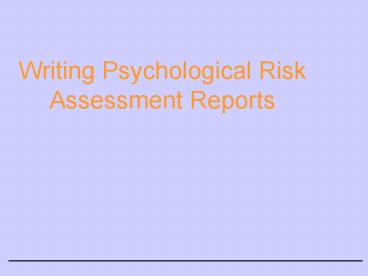Writing Psychological Risk Assessment Reports - PowerPoint PPT Presentation
1 / 16
Title:
Writing Psychological Risk Assessment Reports
Description:
To develop psychologists' skills for ... Engagement in sentence planning meeting targets ... Use of quotes from lifer accurate and fair representation ... – PowerPoint PPT presentation
Number of Views:34
Avg rating:3.0/5.0
Title: Writing Psychological Risk Assessment Reports
1
Writing Psychological Risk Assessment Reports
2
Aims and Objectives
- Aim
- To develop psychologists skills for clearly,
accurately and fairly communicating their
conclusions and recommendations based on a
psychological risk assessment - Objectives
- To review key psychological principles and
practical considerations informing preparation of
reports - To describe key contents and structures for
reports - To provide practice drafting a report based on
case study materials
3
Stages of Report Writing
- Planning
- Drafting and redrafting sometimes useful before
final interview - Disclosure and redrafting
- Submission deadlines, link to KPT, fairness in
process
4
Planning
- Clear about purpose
- Knowledge of research on risk assessment and
relevant factors in case e.g. sexual
offending/violent offending - Familiarity with accepted format
- Thorough file review check official account,
seek maximum info for corroboration - Liaise with Multi-Disciplinary Team
5
Drafting and Redrafting
- Rough draft initial structure with bullet
points - Identifying gaps and addressing through follow-up
interview - Discussing first draft in supervision and
responding to feedback from supervisor - Disclosure of report and responding to any
concerns raised by individual (if appropriate)
6
Structure and Content of Reports
- Depends on purpose of report
- Usually to inform overall risk assessment and
management process
7
Knowledge of the Prisoner
- Report writers credentials
- Previous and current offences
- stage of sentence
- purpose of report
- Amount of contact with individual
- Documents read
- Psychometrics used
- Consent
- Presentation in interview
8
Attitude to the offence(s)
- Individuals account of offence
- Antecedents and patterns of behaviour
- Discrepancies with official accounts
- Level of personal responsibility
- Extent of remorse/regret
9
Insight into Identified Risk Factors
- Content
- Risk factors
- Level of insight
- Concrete evidence e.g. behaviour
- Impact of work on level of risk
- Identify protective factors
- Identify further work/progress needed
- Issues
- Factors identified by whom?
- Consider strength/credibility of evidence
- Protective factors can inform risk
management/release plan
10
Behaviour in Prison/on licence
- Content
- Employment//Education
- Individual and groupwork
- Adjudications/MDTs/
- GOAD/IEP/F2052SH forms/warning letters
- Behaviour in hostel
- Relationships with others
- Temporary releases and community work
- Issues
- Link to relevant risk factors
- Check security files, wing history sheets, seek
reports from community contacts
11
Life Sentence Plan
- Engagement in sentence planning meeting targets
- Group and 1-1 work attendance and summary of
progress - Outstanding areas of need or work
12
Reduction in Risk
- Summarise report
- Current level risk
- Acceptability of risk
- Factors that may increase/decrease/
- maintain current level of risk
- Recommendations for further work
13
Presentational and Style
- Consistent style for peoples titles and
references - Subheadings, numbered paragraphs and cross
referencing/Page numbers - Concise focus on purpose of report
- Fair and reasonable - non-judgemental tone,
language/evidenced
14
Presentation and Style
- Use of quotes from lifer accurate and fair
representation - Consider readership e.g. jargon, ambiguity,
motivational style - Avoid assumptions and consider possible
alternative interpretations balanced view - Distinguish between fact and opinion
15
Disclosure
- Ensure report is supervised prior to disclosure
- Personal safety
- Ways to avoid nasty surprises
- Actively check understanding (even if cant get
agreement) - Be clear about what you are willing to alter if
provided with additional info - Confidentiality of report - sharing with
multi-disciplinary team/security
16
In Summary
- Be concise
- Only include what you can evidence
- Be clear about what is your opinion
- Reference risk assessment tools
- Be prepared to defend your report to the offender
and others - Be aware of the weight given to psychologists
reports































